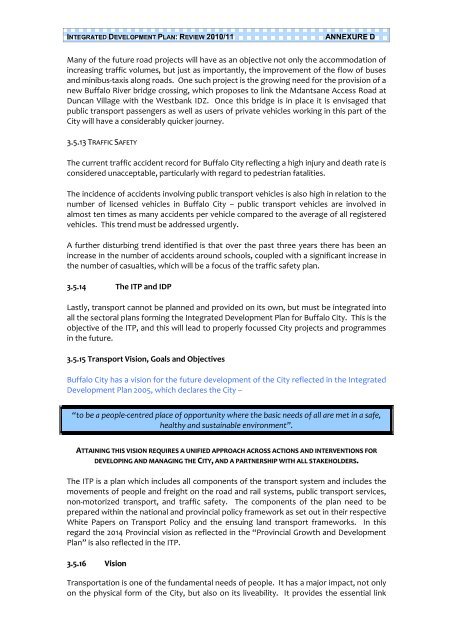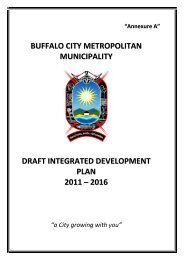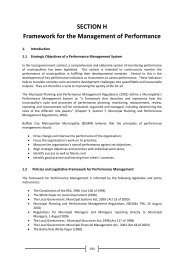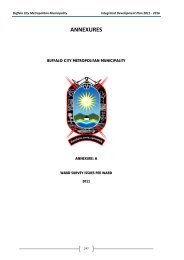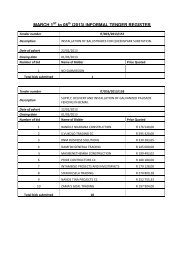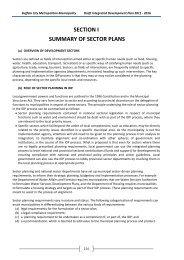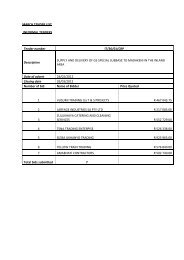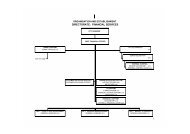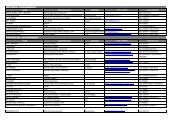annexure d executive summary of bcm sector plans - Buffalo City
annexure d executive summary of bcm sector plans - Buffalo City
annexure d executive summary of bcm sector plans - Buffalo City
You also want an ePaper? Increase the reach of your titles
YUMPU automatically turns print PDFs into web optimized ePapers that Google loves.
INTEGRATED DEVELOPMENT PLAN: REVIEW 2010/11ANNEXURE DMany <strong>of</strong> the future road projects will have as an objective not only the accommodation <strong>of</strong>increasing traffic volumes, but just as importantly, the improvement <strong>of</strong> the flow <strong>of</strong> busesand minibus-taxis along roads. One such project is the growing need for the provision <strong>of</strong> anew <strong>Buffalo</strong> River bridge crossing, which proposes to link the Mdantsane Access Road atDuncan Village with the Westbank IDZ. Once this bridge is in place it is envisaged thatpublic transport passengers as well as users <strong>of</strong> private vehicles working in this part <strong>of</strong> the<strong>City</strong> will have a considerably quicker journey.3.5.13 TRAFFIC SAFETYThe current traffic accident record for <strong>Buffalo</strong> <strong>City</strong> reflecting a high injury and death rate isconsidered unacceptable, particularly with regard to pedestrian fatalities.The incidence <strong>of</strong> accidents involving public transport vehicles is also high in relation to thenumber <strong>of</strong> licensed vehicles in <strong>Buffalo</strong> <strong>City</strong> – public transport vehicles are involved inalmost ten times as many accidents per vehicle compared to the average <strong>of</strong> all registeredvehicles. This trend must be addressed urgently.A further disturbing trend identified is that over the past three years there has been anincrease in the number <strong>of</strong> accidents around schools, coupled with a significant increase inthe number <strong>of</strong> casualties, which will be a focus <strong>of</strong> the traffic safety plan.3.5.14 The ITP and IDPLastly, transport cannot be planned and provided on its own, but must be integrated intoall the <strong>sector</strong>al <strong>plans</strong> forming the Integrated Development Plan for <strong>Buffalo</strong> <strong>City</strong>. This is theobjective <strong>of</strong> the ITP, and this will lead to properly focussed <strong>City</strong> projects and programmesin the future.3.5.15 Transport Vision, Goals and Objectives<strong>Buffalo</strong> <strong>City</strong> has a vision for the future development <strong>of</strong> the <strong>City</strong> reflected in the IntegratedDevelopment Plan 2005, which declares the <strong>City</strong> –“to be a people-centred place <strong>of</strong> opportunity where the basic needs <strong>of</strong> all are met in a safe,healthy and sustainable environment”.ATTAINING THIS VISION REQUIRES A UNIFIED APPROACH ACROSS ACTIONS AND INTERVENTIONS FORDEVELOPING AND MANAGING THE CITY, AND A PARTNERSHIP WITH ALL STAKEHOLDERS.The ITP is a plan which includes all components <strong>of</strong> the transport system and includes themovements <strong>of</strong> people and freight on the road and rail systems, public transport services,non-motorized transport, and traffic safety. The components <strong>of</strong> the plan need to beprepared within the national and provincial policy framework as set out in their respectiveWhite Papers on Transport Policy and the ensuing land transport frameworks. In thisregard the 2014 Provincial vision as reflected in the “Provincial Growth and DevelopmentPlan” is also reflected in the ITP.3.5.16 VisionTransportation is one <strong>of</strong> the fundamental needs <strong>of</strong> people. It has a major impact, not onlyon the physical form <strong>of</strong> the <strong>City</strong>, but also on its liveability. It provides the essential link


